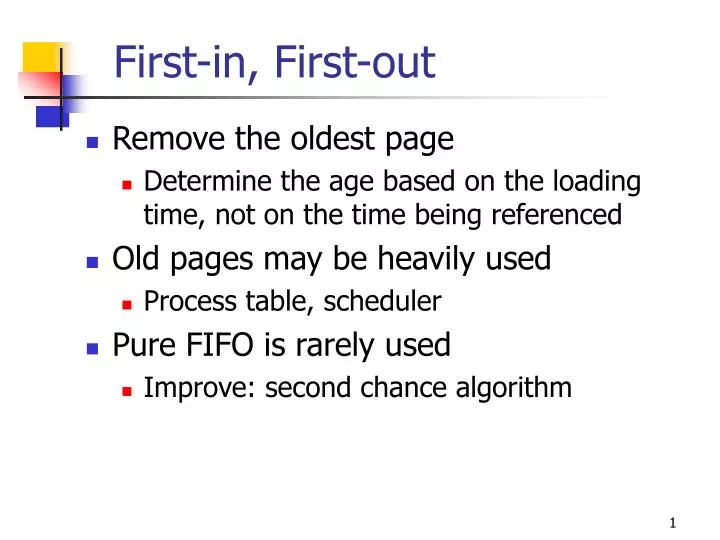16 Aug FIFO First-In-First-Out approach in Programming

Most managers can’t track every individual fruit or vegetable as it comes in and out. A restaurant may want to use the first in, first out (FIFO) method to track the value of its inventory. Even if the first products that went into storage aren’t the first to come out, this method provides a good estimate. (This ensures that stored parts do not become obsolete and that quality problems are not buried in inventory.) It is is a necessary condition for pull system implementation. We recommend consulting a financial expert before making any decisions around inventory valuation.
Why is choosing a method of inventory valuation important?
However, brands using LIFO usually see a lower valuation for ending inventory and net income, and may not reflect actual inventory movement. FIFO, on the other hand, is the most common inventory valuation method in most countries, accepted by International Financial Reporting Standards Foundation (IRFS) regulations. LIFO stands for “last in, first out,” which assumes goods purchased or produced last are sold first (and the inventory that was most recently purchased will be sent to customers before the oldest inventory).
What is the biggest con of using the FIFO method?
Get this right and you’ll make life a lot easier at the end of the financial year – get it wrong and your risk of incorrectly filing your taxes skyrockets. A simple guide to accounting, recordkeeping, and taxes for property management income tax features of c corporations businesses. Bertie also wants to know the value of her remaining inventory—she wants her balance sheet to be accurate. The oldest bars in her inventory were from batch 1 so she will count 100 at the unit cost of batch 1, $2.00.
When to Consider Other Inventory Methods
All companies are required to use the FIFO method to account for inventory in some jurisdictions but FIFO is a popular standard due to its ease and transparency even where it isn’t mandated. That means that the remaining inventory is worth $23,625 ($75,145 total costs – $51,520 of COGS) using the FIFO method. Milagro’s controller uses the information in the preceding table to calculate the cost of goods sold for January, as well as the cost of the inventory balance as of the end of January. At the start of the financial year, you purchase enough fish for 1,000 cans. Organising your inventory and calculating the cost of your goods is a fundamental part of running an efficient business.

How FIFO works (an example)
- First, we add the number of inventory units purchased in the left column along with its unit cost.
- But regardless of whether your inventory costs are changing or not, the IRS requires you to choose a method of accounting for inventory that’s consistent year over year.
- Under the FIFO method, the earliest goods purchased are the first ones removed from the inventory account.
- Using FIFO, when that first shipment worth $4,000 sold, it is assumed to be the merchandise from June, which cost $1,000, leaving you with $3,000 profit.
If you have items stored in different bins — one with no lot date and one with a lot date — we will always ship the one updated with a lot date first. When you send us a lot item, it will not be sold with other non-lot items, or other lots of the same SKU. The first guitar was purchased in January for $40.The second guitar was bought in February for $50.The third guitar was acquired in March for $60. In the FIFO Method, the value of ending inventory is based on the cost of the most recent purchases.
Throughout the grand opening month of September, the store sells 80 of these shirts. All 80 of these shirts would have been from the first 100 lot that was purchased under the FIFO method. To calculate your ending inventory you would factor in 20 shirts at the $5 cost and 50 shirts at the $6 price. So the ending inventory would be 70 shirts with a value of $400 ($100 + $300). It’s also the most accurate method of aligning the expected cost flow with the actual flow of goods. It reduces the impact of inflation, assuming that the cost of purchasing newer inventory will be higher than the purchasing cost of older inventory.
To deal with that, FIFO counts the cost of the product that has been in the inventory account the longest. In other words, it assumes the assets the company made or bought first are sold first. To ensure the effectiveness of your FIFO processes, it is crucial to have well-trained inventory and order fulfillment employees. Educate your employees and provide comprehensive training about the importance of FIFO, along with the specific implementation and management procedures relevant to their roles.
This is because FIFO prioritizes the sale of older inventory items before newer ones, which could lead to potential losses if more in-demand products don’t sell. Using FIFO, you assume the first 1,000 sold cost $1 per unit, and the remaining 500 cost $2 per unit. That leaves you with 500 units in our ending inventory, valued at $2 per unit. Using FIFO, when that first shipment worth $4,000 sold, it is assumed to be the merchandise from June, which cost $1,000, leaving you with $3,000 profit.

No Comments